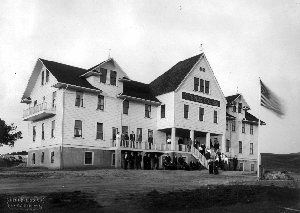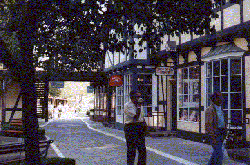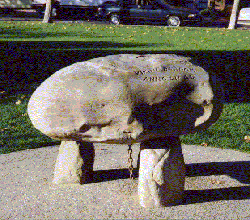Anders Linde-Laursen
Solvang:
A Historical Anthropological Illumination of an
Ethnicized Space
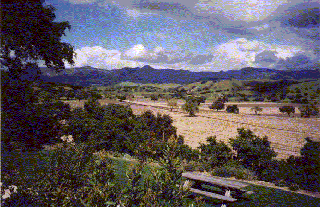 Please imagine a hilltop
situated in a quite green valley - an idyllic
place surrounded by scattered oaks and farmhouses,
vineyards, orchards, and grazing cattle. Then bestow on
this place an ideal climate: it is rarely very hot or
very cold. While it seldom rains, the winds from the
nearby ocean bring enough moisture to keep things green
throughout most of summer. This enchanted place must
indeed be an ideal spot for people to relax and to
recover from the stress and inconveniences of Modern City life.
Please imagine a hilltop
situated in a quite green valley - an idyllic
place surrounded by scattered oaks and farmhouses,
vineyards, orchards, and grazing cattle. Then bestow on
this place an ideal climate: it is rarely very hot or
very cold. While it seldom rains, the winds from the
nearby ocean bring enough moisture to keep things green
throughout most of summer. This enchanted place must
indeed be an ideal spot for people to relax and to
recover from the stress and inconveniences of Modern City life.
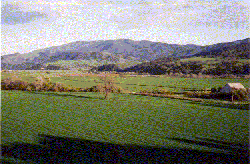 It is
possible to suppose that I am speaking1 of a
remote place, hard to access. A place
spared from the effects of cultural processes associated
with Modernity such as urbanization, capitalization,
emigration, secularization... You might even think that I
am talking of a pastoral community, a
"Gemeinschaft" enduring on the outskirts of the
world.
It is
possible to suppose that I am speaking1 of a
remote place, hard to access. A place
spared from the effects of cultural processes associated
with Modernity such as urbanization, capitalization,
emigration, secularization... You might even think that I
am talking of a pastoral community, a
"Gemeinschaft" enduring on the outskirts of the
world.
Nothing, however, could be more wrong than this visualization. The hilltop I am talking about is a mesa situated between San Francisco and Los Angeles, close to highway 101. The village located on top this hill is visited each year by 1.5 million tourists who come to spend a day or more. Hence, this hilltop is not a remote Gemeinschaft, rather a local place in the very swirl of Gesellschaft.2
Solvang, the incorporated township on top of the hill is a village or small town of around 5200 people lying some forty miles north of Santa Barbara and three miles from Buellton, a township on highway 101. An alternative name often employed for Solvang is "The Danish Capital of America". For a couple of years, I have been interested in this town and its history and I have stayed there during most of 1998 to conduct anthropological and historical research. In this paper, I am trying to sketch some questions on landscape and architecture that seem to me to be crucial for an understanding of the place.
In the following, I will give
an outline of the history of Solvang and its
architecture.
 The town's appearance is important, because both
locals and visitors often mention it as the most
important reason to visiting the town. After that, I will
discuss the possibility for different groups to obtain
identity in this landscape of artificial half-timbering,
fake thatched roofs, and windmills.
The town's appearance is important, because both
locals and visitors often mention it as the most
important reason to visiting the town. After that, I will
discuss the possibility for different groups to obtain
identity in this landscape of artificial half-timbering,
fake thatched roofs, and windmills.
Danes founded Solvang in 1911 on an earlier Spanish land-claim. The founding fathers of the town were first generation Danish immigrant farmers from mid-western states who moved on to milder climate. They intended to create in Solvang a community in which they could preserve their Danish culture and language as well as pass it on to coming generations. Hence, they established their everyday life around institutions, which they understood as being affiliated with something Danish: a Lutheran congregation, a village hall, and a folk-high-school. Solvang, although appearing externally as any other contemporary small community in that part of the US, was thus Danish because of the town-dwellers convictions and daily practices.
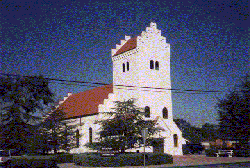
a Lutheran congregation
folk-high-school
In 1936, Solvang celebrated its 25th anniversary with a festival: Danish Day. At the same time as the people of Solvang celebrated themselves as a Danish community and displayed their Danishness to out-of-towners, indications of serious ruptures started to emerge in the Danish practices of the community. Many of the Danish institutions were eventually abandoned and Danish language disappeared from the public scene from the 1930s through the 1960s. Along with the institutions and Danish language went what could have regenerated and secured the Danish practices of generations to come. Thus, the pioneers wish to establish a specific kind of Danish everyday life did not progress further than their own generation.
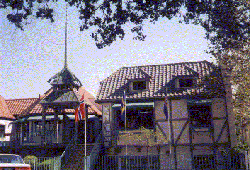 |
At the same time as the Danish practices of Solvang started to disintegrate, contrary processes began to gain power. The community started more intensively to mark its Danish roots. |
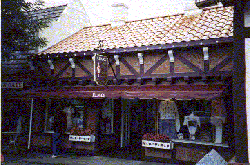 |
It proceeded with celebrating the town's Danish affiliation through yearly Danish Days and after the Second World War a special style in architecture, called "Danish provincial", began and developed rapidly. |
| At the same time the first copy of a series of windmills was erected.– Today the imitated half-timbering of "Danish Provincial" and the copies of windmills create a significant landscape, which in itself is regarded as the most conspicuous symbol of the town's Danishness: "Solvang's architecture is unquestionably its most distinguishing feature. Even visitors from Denmark frequently attest to its authenticity", as it was recently expressed by the leader of the local Visitors Bureau.3 |
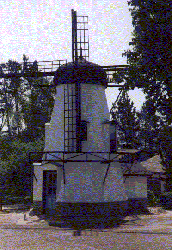 |
Local writings and a strong local narrative of the
town's history4 most often claim that an
article in the January 1947 issue of the Saturday
Evening Post baptized Solvang as a tourist town. The
illustrated story contained pictures of "Danish
provincial" and dancing, smiling, and cheerful
people dressed up in folk costumes. Thus, at the same
time as many of the original institutions of Solvang
abandoned their Danish roots or vanished, "all that
is Danish" became marketed to tourists and that
principle became vital to the town.
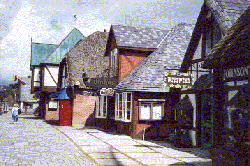 The development of the town's Danish appearance
was started much by chance through the efforts of
individuals. From the 1950s and 60s, however, the
expansion of "all-Danish" was based on economic
considerations and was supported by political decisions
in the community. New buildings and activities were added
to the town's repertoire. However, these houses,
festivals, museums, rooms for wine tasting, and golf
courses were not all established by people who had any
personal affiliation with Denmark but by white people of
European descent in general.
The development of the town's Danish appearance
was started much by chance through the efforts of
individuals. From the 1950s and 60s, however, the
expansion of "all-Danish" was based on economic
considerations and was supported by political decisions
in the community. New buildings and activities were added
to the town's repertoire. However, these houses,
festivals, museums, rooms for wine tasting, and golf
courses were not all established by people who had any
personal affiliation with Denmark but by white people of
European descent in general.
On its exterior, Solvang has probably never been as Danish marked as it is at the present. Everywhere references to "Danish" are included – in aesthetics, taste, and signs. The village's Danishness materializes itself on buildings, T-shirts, restaurant menus, street- and store-names, and in many other places. The history of one of the very earliest houses in Solvang can illustrate how the steadily growing demand for more Danish signifiers pattern the town's landscape:
This house was built in 1911. Until 1914, it housed the Danish folk-high-school and the Lutheran Congregation. Regardless of its outer appearance, the building was then essential to the community's Danish practices and everyday life.
In 1931, the house was remodeled as a restaurant and rooming house. Still not especially Danish looking it at least had a Danish name after its owner: Knudsen's Coffee Shop.
Some years later the look
of the building was significantly changed.
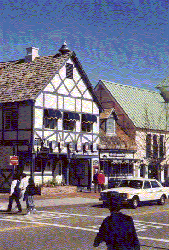 A picture from the mid-1960s and another from the spring of 1998 illuminates
how the house has been completely redressed since it was
built in 1911 to meet a steadily growing demand for
something authentic, Danish. Similar processes of progressive
authentication have reshaped
many other buildings in Solvang's business district.
A picture from the mid-1960s and another from the spring of 1998 illuminates
how the house has been completely redressed since it was
built in 1911 to meet a steadily growing demand for
something authentic, Danish. Similar processes of progressive
authentication have reshaped
many other buildings in Solvang's business district.
The Norwegian anthropologist Marianne
Gullestad5 has distinguished the study of the
national into two fields. The first, National cultural
processes, are processes through which something is
invented, institutionalized, and sacralized as something
National. The second, cultural processes within a
nation are homogenizing processes within the
political territory of a nation state. Both these
processes have been at work in the elaboration of
Solvang. Cultural processes that are marked more by the
American context than by anything Danish form the town's
landscape and social life. While Solvang in this sense is
American, the town is also a display of the community's
skillful use of "all-Danish" as the platform for
the local tourist industry. From how this platform is
presented in marketing materials and from how it is
materialized in the town's shops it is obvious,
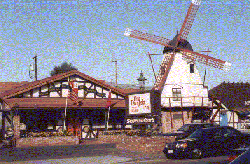 that the business people are aware of which
elements can be marketed as Danish with success. The
things they choose are all part of Danish national
cultural processes. Consequently, Solvang contains
signifiers similar to those marketed by tourist
organizations from Denmark in their attempt to make the
country attractive to visitors. In Solvang there are many
references to Hans Christian Andersen and The
Little Mermaid, The Round Tower of Copenhagen and
Vikings. The town's houses festivals, and menus display ,
supposedly Danish half-timbering and mills,
folk-traditions, food and taste. Even if the image of
Solvang can not totally match the original, it is clear
that the elements and structures of "Danishness" in the
images are similar if not identical.
that the business people are aware of which
elements can be marketed as Danish with success. The
things they choose are all part of Danish national
cultural processes. Consequently, Solvang contains
signifiers similar to those marketed by tourist
organizations from Denmark in their attempt to make the
country attractive to visitors. In Solvang there are many
references to Hans Christian Andersen and The
Little Mermaid, The Round Tower of Copenhagen and
Vikings. The town's houses festivals, and menus display ,
supposedly Danish half-timbering and mills,
folk-traditions, food and taste. Even if the image of
Solvang can not totally match the original, it is clear
that the elements and structures of "Danishness" in the
images are similar if not identical.
The Swedish-American folklorist Barbro Klein6 describes in a study what happens with Swedish traditions in an American context. In Solvang, similar processes shape the transformation of cultural elements following Danes across the Atlantic. Elements surviving the transfer are often connected to an agrarian-religious cycle of the year and they represent traditions of people who were not poor. Among the different kinds of tradition, sound, dance, material objects, and food continue to be in use while verbal traditions have vanished – not least, because they exclude all non-competent people from participation. This exclusion of verbal tradition is a functional precondition at big events – like Danish Days in Solvang – where a lot of individuals are offered access or demand access to a group, which they usually do not belong to.
In Solvang's landscape, constructed along these lines of development, one can easily identify two groups of people. The first group is the local vendors. If interviewed about the town and its history they most often respond with a more or less developed version of the above repeated story. In 1990, only around 20 percent of the population of the town had Danish roots. This fraction, however, seem completely to dominate the public image of the town. Many locals of non-Danish descent affiliate themselves with this minority of Danish origin. In interviews, they explain how their biography has merged with the town in very harmonious ways. They stress community, family values, and safety in their everyday life as common ground with the Danes and ascribing these community qualities to the national background of the pioneers. So, even if the local Danes form a minority, many other people of European descent associate themselves with this minority forming, as it seems, a coherent Danish imagery. This composed Danish imagined community today encompasses not only vendors, but also commuters living in Solvang and working mostly in Santa Barbara, as well as a fairly large group of retirees.
The second group, which is easily identifiable, consists of the visitors. During the day, they comprise the bulk of people one meets in the "downtown" - touristic - section of the village. The overwhelming majority of visitors are white, middle class Californians from the cities: LA, San Francisco, San Jose, Santa Barbara, Santa Maria... The influx of foreigners, besides an occasional busload of Japanese tourists, is small and only rarely one meets African-Americans in this group. People talking Spanish are, as will be discussed further below, not represented in this group to the extent one might imagine from the ethnic composition of Solvang and of its surroundings. Thus, in general the individual visitor can easily melt into the picture of Danish Solvang and subscribe to its "general Scandinavian" or "European" feeling, as they answer when asked about why they go here.
There is at this point little reason to doubt, that one of the major reasons why so many people today visit Solvang is exactly the ability of its landscape to incorporate every(white)one into its imagery of a village of the Old, European, World. Thus, the very attraction of Solvang might very well be depicted as its way of conveying to the visitor an uncomplicated image of a Danish/European Gemeinschaft, which everyone can join – for a day or a lifetime.
However, if one observes more carefully the everyday life of Solvang or moves beyond the downtown area, one can identify an additional group present in the village. This third group consists of what locals call "Mexicans" – a group of people with very different biographies and legal statuses. The label "Mexican" has many facets. The label lumps together characteristics as: Spanish speaking, illegal immigrant, Roman Catholic, poor sense for the quality of work, uneducated, poverty, criminality... Being Mexican, thus, is being the opposite of what local whites/Danes want and try to associate themselves with, and being Mexican is a direct contradiction of what the town's merchants try to sell to their visitors.
The town's tourist industry is heavily dependent upon the Mexicans. Even if they are a group of newcomers, who have appeared in the village during the last two decades, they form today the majority of employees on the village's backstage. Restaurant cooks and dishwashers, motel cleaners and gardeners, and bakers are today most often Mexicans.
Today, when half the children starting in the local school speak Spanish at home, Solvang's imagery of an Old World Gemeinschaft is cracking. This is observed by white locals, who complain that a present drop in tourist inflow - whether real or imagined - is due to the hiring of Mexicans. Many locals explain that the village looses its unique charm, when the visitors are no longer served in the shops and restaurants by tall, blond Scandinavians. As a reminder from a modern complex Gesellschaft, the Mexicans destroy the locals' cherished Danish landscape. Even if local whites themselves employ the Mexicans, due to the lower cost, they abhor the simultaneous lose of the town's imagined Gemeinschaft. To the white/Danes, Mexicans are not supposed to be there and if they have to be around, they ought to stay invisible.
The Mexicans are, thus, mostly still
kept backstage, even if they have in the last few years
also started to appear as waiters and shop clerks. In
addition, they have no opportunity to present themselves
as part of the village's history whether in written
accounts or through representation in the landscape.
Solvang indeed has an early-early Chumash, or
Native-American, history, as well as an early Spanish and
Mexican history. The history of the Chumash is banished
from Solvang and conveniently located in a reservation
– with a casino – some miles away. Solvang shares its
hilltop with the 19th of the twenty-one
missions that formed the backbone of the Spanish/Mexican
administration of Alta California from the late 1700s.
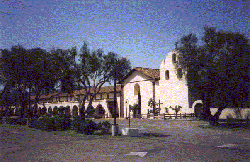 The Old Mission Santa Inez, which was build in
1804, is today a historical landmark, situated right off
downtown Solvang. However, in the local narrative, the
history of the hilltop's Spanish and Mexican history
often starts and ends with the founding of the Mission in
1804, if not with a futile Indian uprising there in 1824.
In narrative, the modern history of the hilltop starts
first with the arrival of the Danes in 1911. Thus, local
Mexicans are not only relatively invisible in the
landscape; they are also excluded from establishing
themselves with representations in this landscape. A
signifier for the Mexicans would by the white/Danish
dwellers and merchants of the town be perceived as an
inappropriate adoption of an unwelcome sign of
Gesellschaft, and such a representation, they imagine,
would harm the tourist industry.
The Old Mission Santa Inez, which was build in
1804, is today a historical landmark, situated right off
downtown Solvang. However, in the local narrative, the
history of the hilltop's Spanish and Mexican history
often starts and ends with the founding of the Mission in
1804, if not with a futile Indian uprising there in 1824.
In narrative, the modern history of the hilltop starts
first with the arrival of the Danes in 1911. Thus, local
Mexicans are not only relatively invisible in the
landscape; they are also excluded from establishing
themselves with representations in this landscape. A
signifier for the Mexicans would by the white/Danish
dwellers and merchants of the town be perceived as an
inappropriate adoption of an unwelcome sign of
Gesellschaft, and such a representation, they imagine,
would harm the tourist industry.
Local white/Danes as well as the vast majority of visitors – both groups consisting mostly of people of mixed European origins – find in Solvang's landscape elements that allow them to obtain identity. They acquire identity from feeling included or excluded from the imagined Old World, European Gemeinschaft of Solvang in its American context. Thus, from this perspective Solvang has very little to do with Danishness as such and very much to do with establishing and confirming white, middle class, English speaking, American normality. However, this normality excludes Spanish speaking, poorer, Catholic, so-called Mexicans, who by the whites are identified with negative effects of Modernity, such as multiculturalism, and who are therefor disturbing the clean and safe imagined Gemeinschaft of Solvang. Actively excluded as an element of an undesired Gesellschaft the Mexicans tend to be invisible in downtown Solvang. While older Mexicans, who are born elsewhere, have biographies anchored outside the community, a new generation of individuals is growing up in today's Solvang. These young Mexicans, born and raised in the town, are in a difficult situation. On the one hand they live in the town and must try to make sense of its landscape; on the other hand this landscape makes them invisible and offers them no chance of being represented. How the young Mexicans handle their marginal situation is part of my ongoing research. However, an indication of the their stance might come from a local, who talked of the youth as "a very angry young bunch".
In conclusion I might emphasize, that I am looking at Solvang's landscape and these three groups from a perspective offering privilege to a specific kind of identity, which might be termed ethnic or national. This, however, does not mean that I find that ethnic or national identity is more important or basic than other aspects of individuals or groups identity build upon other characteristics as for instance: class, gender, age, or generation. In an analysis of Solvang's landscape, as the most important signifier for the town's particularity as Danish, I, however, regard the ethnic/national approach as the most rewarding.
If we want more in detail to illuminate
relations between identity formation and landscape, it is
my point here that we have to study closely how
landscapes – as for instance Solvang's – are
both historically organized by social relations and
themselves are the material frameworks within which
social relations
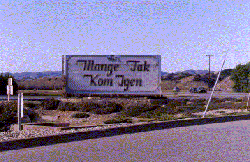 are performed
as inclusion and exclusion... short: as executions of
powers. If we recognize, that processes of identity
formation are dependent on the ability of groups to
distinguish themselves as different from others at the
same time as they are recognized by these others as a
distinct group an understanding of "landscape"
also as a social process could turn out to be very
fruitful.
are performed
as inclusion and exclusion... short: as executions of
powers. If we recognize, that processes of identity
formation are dependent on the ability of groups to
distinguish themselves as different from others at the
same time as they are recognized by these others as a
distinct group an understanding of "landscape"
also as a social process could turn out to be very
fruitful.
Thank you – or as they say in Solvang: "Mange tak".
1 This text was presented first as a
paper at the Society of Architectural Historians Annual
Meeting in Los Angeles, April 15-19, 1998. It was
presented in the session: "Architecture as Sign in
Ethnic American Communities", which was organized
and chaired by Lynne Horiuchi, University of California,
Santa Barbara.
Where nothing else is mentioned all photos are taken by
the author during fieldwork in Solvang in 1992, 1996, and
1998.
2 I should note here
that throughout this paper I am employing the
sociological concepts Gemeinschaft and Gesellschaft to
discuss my topic. Gemeinschaft denotes a simple,
small-scale, traditional, and stable community, whereas
Gesellschaft implies the ever-changing context for
everyday life in complex, modern societies. I use these
concepts not to describe the true conditions of everyday
life, but in order to illuminate ideal and imagined
pictures of how life could or ought to be.
I am referring here to discussions by the Finnish-Swedish
sociologist Johan Asplund in Essä om Gemeinschaft och
Gesellschaft (Gothenburg: Korpen, 1991).
3 Solvang, California. Danish Capital of America.Destination Guide 1997, p. 17.
4On the history of the town, see: Tore Kristiansen, Jake Harwood & Howard Giles: Ethnolinguistic Vitality in 'The Danish Capital of America'. Journal of Multilingual and Multicultural Development vol. 12, No. 6, pp. 412-448, 1991. And for a local voice: Elaine Revelle: Solvang. Denmark in the USA (Fourth edition). Solvang: The Book Loft, 1991.
5 Marianne Gullestad: Small Facts and Large Issues: The Anthropology of Contemporary Scandinavian Society. Annual Review of Anthropology, vol 18, pp. 71-93, 1989.
6Barbro Klein: Den gamla hembygden eller vad har hänt med de svenska folktraditionerna i USA? Åke Daun & Billy Ehn (eds.): Blandsverige. Om kulturskillnader och kulturmöten, pp. 43-67. Stockholm: Carlssons, 1988.

